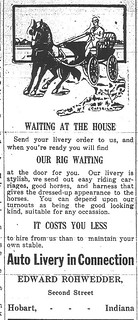
(Click on image to enlarge)
Advertisement for Edward Rohwedder's livery service, from the Hobart News of July 11, 1912.
On April 19, 1912, a couple of traveling salesmen, who had come from Cedar Rapids via Chicago, arrived in Hobart. One was a youth of twenty named Harold McCauley; the other an older man known only as J. Moore. They represented manufacturers of various items, including different types of polish and vinegar, and they went about making sales calls on area merchants, with some success.
As might be expected, the young Harold did not stick strictly to business. Good-looking and glib, he made friends easily, and before a week had gone by he was paying particular attention to a Hobart girl (name unknown). He asked her for a date to the Saturday-night dance at Ainsworth scheduled for April 27. She said yes.
But Harold had a problem — he was flat broke. His employer hadn't yet paid him for his Hobart sales orders; on the Thursday before the dance, he wrote home to beg for money, but had not heard back by Saturday. How on earth was he going to hire a rig to take his girl down to Ainsworth? He couldn't pay cash, and since he was such a recent arrival in Hobart, there was no reason why any livery stable would trust him for the fee on credit.
Then he had a brilliant idea: he would forge a check — not to cash it, but simply to show it to a livery stable owner in order to establish his credit. And then when his employer paid him or the money from home arrived, he could pay off the livery stable, and no harm done, right?
Late on Saturday afternoon, Harold went to the post office and there wrote himself a check in the amount of $89, drawn on the First State Bank in Hobart, and signed by "F. Jones, Mdg. Egr. G. H. & E. R.R." — i.e., an engineer for the Gary, Hobart and Eastern Traction Company, which ran the newly established streetcar service between Hobart and Gary.
Harold asked a boy at the post office where he could go to get the check cashed, explaining that he wanted to hire a rig to go to the dance. The boy told him to go to the Gazette office (whether seriously, or suspecting fraud and intending to send the criminal directly into the arms of the newspaper editor, I don't know). Harold didn't take his advice, but someone alerted the editor of the Gazette, who then went to the Rohwedder livery stable, where he found Harold and his girlfriend waiting for their rig.
By offering to cash the check, the editor got Harold to show it to him. He thought it looked bogus. Now Marshal Fred Rose was called in. He thought the check a fake, too, but nonetheless set out looking around town for the check's alleged writer, "F. Jones." After an hour's fruitless search, the Marshal returned to speak to Harold again, only to find that he no longer had the check — it had mysteriously vanished. Harold was invited to spend the night in jail.
On Sunday morning Marshal Rose came across pieces of the check lying in the street. Harold soon broke down and confessed the whole scheme, explaining that while Rose was out looking for "F. Jones," Harold had finally torn up the check and thrown it on the street.
The Marshal called Harold's brother, who lived in Milwaukee. After coming to Hobart Sunday evening, the brother told the Marshal that to his knowledge, Harold "had never done anything criminally wrong, although he had been, like many boys of today, a little wild, being the youngest of the family and had never known what 'hard luck' meant."
Harold remained in jail Sunday night.
On Monday, the mail brought him a letter from his mother, containing $20. But, of course, it was too late to do Harold any good. That same day he was released to the custody of his brother, who promised to take him back to Milwaukee and make him behave better in the future.
Source: "Presents Forged Check." Hobart Gazette 3 May 1912.


3 comments:
It's so much fun to see a familiar name in your articles. Edward Rohwedder was my husband's grand-father. We've never seen that ad before but we do have his ledger book filled with lots of Hobart names. We gave it to our son with the hope that he will pass it on to the Historical Society. His livery was located on the lake where the police station is now.
Thanks for the info. I didn't know exactly where the livery was.
Post a Comment